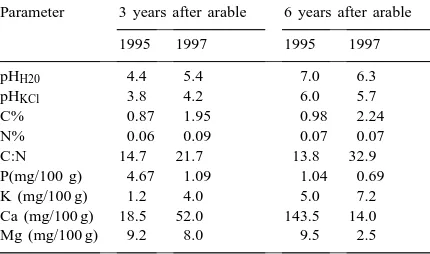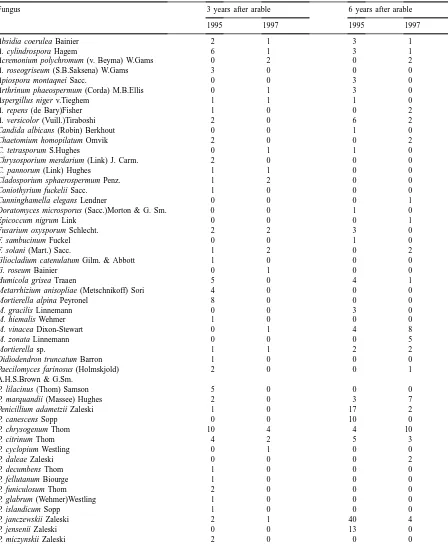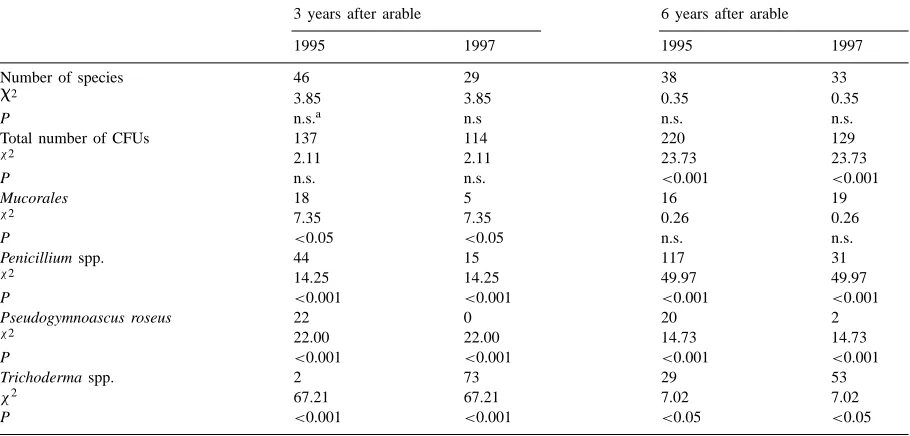Short communication
Fungal communities in fallow soil before and after amending
with pine sawdust
H. Kwa´sna
a,∗, Z. Sierota
b, G.L. Bateman
caDepartment of Forest Pathology, University of Agriculture, ul. Wojska Polskiego 71c,60-625 Poznan, Poland bDepartment of Forest Phytopathology, Forest Research Institute, ul. Bitwy Warszawskiej 1920 r. Nr 3, 00-973 Warszawa, Poland
cIACR-Rothamsted, Harpenden, Hertfordshire, AL5 2JQ, UK
Received 6 July 1999; received in revised form 6 January 2000; accepted 18 January 2000
Abstract
Pine sawdust (9 kg m−2) was ploughed into soils, intended for future forestry plantations, that had been left for 3 or 6
years after previously being used for agriculture. Two years after the amendment, soil pH had changed in both sites and the C:N ratio had increased. Total fungal populations decreased after the treatment. A small decrease in the number of species was not statistically significant. Trichoderma harzianum, an important biological control fungus, increased considerably after sawdust application whilst some fungi, such as Penicillium spp., Pseudogymnascus roseus and partially Mucorales decreased. The practical implications of the increase in T. harzianum density for the health of the young forests are discussed. © 2000 Elsevier Science B.V. All rights reserved.
Keywords: Soil fungi; Pine sawdust; Trichoderma harzianum; Biological control; Forestry
1. Introduction
Root rot of conifers caused by Heterobasidion
an-nosum (Fr.) Bref. is very destructive to forest trees.
The disease is particularly severe in first and second generation conifers growing on land that was formerly arable, pasture or moorland. Many attempts have been made to create conditions that favour the build up of fungi antagonistic to H. annosum in field soils. Treat-ments similar to mulching, in which organic amend-ments are added to the soil, are the more popular methods used.
∗Corresponding author.
E-mail address: [email protected] (H. Kwa´sna)
This paper describes an investigation to provide de-tailed information on the structure of fungal commu-nities in formerly agricultural soils subjected to dif-ferent conditions and to seek supporting evidence that adding sawdust causes changes in pH and chemical composition and stimulates the activity of beneficial fungi, i.e. Trichoderma harzianum, which is known for its antagonistic effects on root pathogens such as
H. annosum (Fr.) Bref. (Holdenrieder, 1984).
2. Materials and methods
The study was begun in 1995 in the Gł˛eboki Bród Forest District (Gulbin, Dept 320s) on formerly agri-cultural land, previously used mainly for growing rye and scheduled for forest planting in 1996. The soil
Table 1
Chemical composition of formerly arable soils, left for 3 or 6 years, before (1995) and after (1997) the addition of pine sawdust
Parameter 3 years after arable 6 years after arable
1995 1997 1995 1997
P(mg/100 g) 4.67 1.09 1.04 0.69
K (mg/100 g) 1.2 4.0 5.0 7.2
Ca (mg/100 g) 18.5 52.0 143.5 14.0
Mg (mg/100 g) 9.2 8.0 9.5 2.5
is loosely aggregated gley-podzol developed from terrace sand. Its upper layer contained organic mat-ter from decayed plant roots, stems and leaves. Soil pH is given in Table 1. Two differently treated areas (200 m×15 m) on the same soil were selected. In one, the soil was left under fallow for 3 years following an oat crop. In the other, the soil was left for 6 years, the first 3 years under grass followed by 3 years fallow. In autumn 1995, after the last year of fallow, six soil cores (20 cm deep×7 cm diam.) were taken from each of four plots (25 m2), one plot at each corner of each site. The upper and lower 5 cm of each core were dis-carded and the central 10 cm retained. After bulking the samples from each plot, part was used for deter-mining some chemical properties of the soil (Table 1). Fungi were isolated using soil–plate method by Warcup (1950) and modified by Johnson and Ma´nka (1961) using the remainder of the sample. This was prepared by mixing each of three replicate 1 g sub-samples with 149 g fine quartz sand, ground initially with a small amount of sand in a mortar for 10–20 s, followed by slow rotation in a sterile flask for a further 10 min. A subsample (0.26 mg) of this was placed in an empty Petri dish and covered with Czapek (Dox) agar containing aureomycin and rose bengal (Johnson and Ma´nka, 1961). Ten plates were prepared in this way from each of the three flasks. The plates were incubated at 25◦C for 7–10 days, after which
indi-vidual fungal colonies were transferred to slopes of potato dextrose agar in test tubes for maintenance and identification. The numbers of colony forming units of fungi (CFU) were determined per mean sample of
8 mg of soil. The method was chosen because of its proven reliability and consistency for qualitative and quantitative analyses of fungal communities in soils (Kwa´sna and Nirenberg, 1994).
After sampling in Autumn 1995, a 5 cm-thick layer (9 kg m−2) of pine sawdust was spread on the treated
areas and the soil ploughed to a depth of about 35 cm. In spring 1996 the soil was again ploughed and harrowed. Scots pine and birch seedlings were then planted (one plant m−2). In Autumn 1997, further
soil samples were collected and subjected to the same chemical and mycological analyses as in 1995.
The statistical significance of differences in num-bers of fungi in differently treated soils was deter-mined byχ2tests.
3. Results
3.1. Chemical analysis of soil
The soil left fallow for 3 years had a lower pH and a lower content of Ca2+, K+and Mg2+than that left
for 6 years (Table 1). Soil pH decreased 2 years after sawdust treatment in the plots that had been left for 6 years but increased in plots that had been left for 3 years. The carbon content and C:N ratio increased as a result of incorporation of sawdust. Phosphorus content decreased, particularly in soil left for 3 years, while K+ content increased. Initial large differences
between sites stabilized to some extent to similar levels 2 years after adding sawdust.
3.2. Fungal communities in soil
The most common fungi before the sawdust incor-poration included Pseudogymnoascus roseus,
Penicil-lium vinaceum and P. chrysogenum in soil left for 3
years and P. janczewskii, T. harzianum and P. roseus in soil left for 6 years (Table 2). There were fewer CFUs in soil left for 3 years than in soil left for 6 years (combining 1995 and 1997 data,χ2=23.73, p<0.001,
suggesting a difference from 1:1 ratio on the two sites) but similar numbers of species (Table 3).
Table 2
Number of colony forming units (CFUs per 8 mg soil sample) of fungal species in formerly arable soils, left for 3 or 6 years, before (1995) and after (1997) the addition of pine sawdust
Fungus 3 years after arable 6 years after arable
1995 1997 1995 1997
Absidia coerulea Bainier 2 1 3 1
A. cylindrospora Hagem 6 1 3 1
Acremonium polychromum (v. Beyma) W.Gams 0 2 0 2
A. roseogriseum (S.B.Saksena) W.Gams 3 0 0 0
Apiospora montaqnei Sacc. 0 0 3 0
Arthrinum phaeospermum (Corda) M.B.Ellis 0 1 3 0
Aspergillus niger v.Tieghem 1 1 1 0
A. repens (de Bary)Fisher 1 0 0 2
A. versicolor (Vuill.)Tiraboshi 2 0 6 2
Candida albicans (Robin) Berkhout 0 0 1 0
Chaetomium homopilatum Omvik 2 0 0 2
C. tetrasporum S.Hughes 0 1 1 0
Chrysosporium merdarium (Link) J. Carm. 2 0 0 0
C. pannorum (Link) Hughes 1 1 0 0
Cladosporium sphaerospermum Penz. 1 2 0 0
Coniothyrium fuckelii Sacc. 1 0 0 0
Cunninghamella elegans Lendner 0 0 0 1
Doratomyces microsporus (Sacc.)Morton & G. Sm. 0 0 1 0
Epicoccum nigrum Link 0 0 0 1
Fusarium oxysporum Schlecht. 2 2 3 0
F. sambucinum Fuckel 0 0 1 0
F. solani (Mart.) Sacc. 1 2 0 2
Gliocladium catenulatum Gilm. & Abbott 1 0 0 0
G. roseum Bainier 0 1 0 0
Humicola grisea Traaen 5 0 4 1
Metarrhizium anisopliae (Metschnikoff) Sori 4 0 0 0
Mortierella alpina Peyronel 8 0 0 0
M. gracilis Linnemann 0 0 3 0
M. hiemalis Wehmer 1 0 0 0
M. vinacea Dixon-Stewart 0 1 4 8
M. zonata Linnemann 0 0 0 5
Mortierella sp. 1 1 2 2
Oidiodendron truncatum Barron 1 0 0 0
Paecilomyces farinosus (Holmskjold) 2 0 0 1
A.H.S.Brown & G.Sm.
P. lilacinus (Thom) Samson 5 0 0 0
P. marquandii (Massee) Hughes 2 0 3 7
Penicillium adametzii Zaleski 1 0 17 2
P. canescens Sopp 0 0 10 0
P. chrysogenum Thom 10 4 4 10
P. citrinum Thom 4 2 5 3
P. cyclopium Westling 0 1 0 0
P. daleae Zaleski 0 0 0 2
P. decumbens Thom 1 0 0 0
P. fellutanum Biourge 1 0 0 0
P. funiculosum Thom 2 0 0 0
P. glabrum (Wehmer)Westling 1 0 0 0
P. islandicum Sopp 1 0 0 0
P. janczewskii Zaleski 2 1 40 4
P. jensenii Zaleski 0 0 13 0
Table 2 (Continued )
Fungus 3 years after arable 6 years after arable
1995 1997 1995 1997
P. rolfsii Thom 0 0 1 0
P. simplicissimum(Oudem.) Thom 1 1 3 2
P. solitum Westling 2 0 1 1
P. spinulosum Thom 2 1 3 1
P. steckii Zaleski 0 3 11 5
P. vinaceum Gilman & Abott 12 0 9 0
P. waksmanii Zaleski 0 1 0 1
Penicillium sp. 2 1 0 0
Phialophora cyclaminis v. Beyma 2 0 0 0
Phoma eupyrena Sacc. 0 1 1 0
cf. Phoma glomerata (Corda)Wollenw.& Hochapfec 2 0 0 0
Pseudogymnoascus roseus Raillo 22 0 20 2
Pyrenochaeta rubi-idaei Cavara 4 0 0 0
Rhizopus arrhizus Fisher 0 0 1 0
Sclerophoma pithyophila (Corda) v. Hohn. 0 1 0 0
Sphaeropsidales 0 0 0 1
Talaromyces flavus (Klocker) Stolk & Samson 0 0 2 0
Trichocladium asperum Harz 0 1 0 0
Trichoderma harzianum Rifai 0 69 25 51
T. koningii Oudemans 2 0 2 0
T. virens (Mil. Gidd. & Fost.) v. Arx 0 4 0 2
T. sp. con.st. Hypocrea 0 0 2 0
Truncatella truncata (Lev.) Steyaert 3 0 0 0
Verticillium bulbillosum W. Gams & Malla 2 0 1 0
Zygorhynchus moelleri Vuill. 1 0 0 1
Sterile mycelia 1 5 7 3
treatment in the soil left for 6 years; a similar ef-fect was found when numbers from both soils were combined. Some of the species previously present or even common were not found: Metarrhizium
aniso-pliae, Mortierella alpina, Penicillium jensenii, P. vinaceum, T. koningiii, Truncatella truncata, Verticil-lium bulbillosum (Table 1). Some species not found
previously were now isolated: Acremonium
polychro-mum, Mortierella zonata, P. waksmanii, Sclerophoma pithyophila, T. virens. Other species were found
both before and after the treatment: Absidia spp.,
P. chrysogenum, P. citrinum, P. janczewskii, P. sim-plicissimum, P. spinulosum. There were significant
decreases after sawdust treatment in the frequencies of Mucorales (only in soil left for 3 years),
Penicil-lium spp. and Pseudogymnoascus roseus (Table 3).
The frequency of Trichoderma spp., particularly of T.
harzianum, increased significantly after addition of
sawdust.
4. Discussion
Fewer microfungi and fewer fungal species (not sta-tistically significant) were found 2 years after adding pine sawdust to formerly agricultural soil left fallow for 3 and 6 years than were found before the sawdust was added. The only species showing a strong positive response to the presence of sawdust in the soil was T.
harzianum. The increase in frequency of T. harzianum
was associated particularly with increased carbon con-tent and C:N ratio. Sawdust is likely to be a good ex-ternal source of nutrient and an additional source of carbon required for germination of T. harzianum.
Table 3
Effects of the addition of sawdust on fungal community structure (total number of species), size (total number of mycelium forming units, CFUs, per 8 mg soil sample) and on number of CFUs of selected fungal taxa in formerly arable soils, left for 3 or 6 years, before (1995) and after (1997) sawdust treatment
3 years after arable 6 years after arable
1995 1997 1995 1997
Number of species 46 29 38 33
x2 3.85 3.85 0.35 0.35
P n.s.a n.s n.s. n.s.
Total number of CFUs 137 114 220 129
χ2 2.11 2.11 23.73 23.73
P n.s. n.s. <0.001 <0.001
Mucorales 18 5 16 19
χ2 7.35 7.35 0.26 0.26
P <0.05 <0.05 n.s. n.s.
Penicillium spp. 44 15 117 31
χ2 14.25 14.25 49.97 49.97
P <0.001 <0.001 <0.001 <0.001
Pseudogymnoascus roseus 22 0 20 2
χ2 22.00 22.00 14.73 14.73
P <0.001 <0.001 <0.001 <0.001
Trichoderma spp. 2 73 29 53
χ2 67.21 67.21 7.02 7.02
P <0.001 <0.001 <0.05 <0.05
an.s.: not significantly different from a 1:1 ratio at p≤0.05.
Considering that T. harzianium occurs infrequently and in small amounts in natural soils (Eastburn and Butler, 1988a), large changes in its frequency may be significant. T. harzianum may have increased grad-ually throughout the investigation period, because populations of this fungus vary only a small amount within seasons and it is usually not dominated by other fungi (Eastburn and Butler, 1988b). In contrast, in the presence of T. harzianum, decreases in Penicillium spp., particularly P. janczewskii (which is reported to be sensitive to antibiotics produced by Trichoderma spp. (Christensen, 1969)) in soil left for 6 years, and in Pseudogymnoascus roseus were observed. T.
harzianum can produce significant amounts of
car-bon dioxide, ethanol and water-soluble antibiotics as well as antifungal, fixed or volatile metabolites that are considered responsible for antibiosis, including the inhibition of growth and sporulation of some soil fungi (Hutchinson and Cowan, 1972; Ghisalberti and Sivasithamparam, 1991; Horvath et al., 1995).
The presence of fresh pine sawdust and the result-ing predominance of T. harzianum are likely to have caused the decreased frequency of fungi with poor
ability to decompose cellulose and hemicellulose, i.e.
P. roseus and Mucorales. P. roseus can decompose
hemicellulose and the wood of deciduous trees (Dom-sch et al., 1980) but no information is availabe on its activity on coniferous wood. Mucorales generally can-not degrade cellulose (Bååth and Söderström, 1980).
The structure of the soil fungal community may result also from interactions among fungi (Widden and Scattolin, 1988) and a mycoparasitism of T. harzianum (Domsch et al., 1980).
The increase in T. harzianum is expected to provide protection of young forest trees from root rot caused by H. annosum. Antagonism of T. harzianum against
H. annosum on artifical media, sterilized wood, on
H. annosum (Hüttermann and Cwielong, 1982). The
enzyme complex obtained in this way was active on
H. annosum in liquid cultures as well as on solid
media and on discs of wood.
Strains of T. harzianum from the Gł˛eboki Bród sites produced a characteristic coconut aroma. Such aro-matic strains usually produce pentyl analogues which show potent inhibitory properties against a wide range of fungi and considerably reduce the rate of the disease (Ghisalberti and Sivasithamparam, 1991). Therefore the Gł˛eboki Bród strains are considered to be disease suppressive.
References
Anselmi, N., Nicolotti, G., Sanguineti, G., 1992. Antagonismo in vitro di Trichoderma spp. contro Basidiomycetes agenti di merciumi radicali di piante forestali. Monte e Boschi 43, 57–59. Bååth, E., Söderström, B.E., 1980. Degradation of macromolecules by microfungi isolated from different podzolic soil horizons. Can. J. Bot. 58, 422–425.
Bruce, A., Highley, T., 1991. Control of growth of wood decay Basidiomycetes by Trichoderma spp. and other potentially antagonistic fungi. For. Prod. J. 41, 63–67.
Christensen, M., 1969. Soil microfungi of dry to mesic conifer-hardwood forests in northern Wisconsin. Ecology 50, 9–27.
Domsch, K.W., Gams, W., Anderson, T.H., 1980. Compendium of Soil Fungi, Vol. 1. Academic Press, New York.
Eastburn, D.M., Butler, E.E., 1988a. Microhabitat characterization of Trichoderma harzianum in natural soil: evaluation of factors affecting population density. Soil Biol. Biochem. 20, 541–545. Eastburn, D.M., Butler, E.E., 1988b. Microhabitat characterization of Trichoderma harzianum in natural soil: evaluation of
factors affecting distribution. Soil Biol. Biochem. 20, 547– 553.
Falk E., 1987. Untersuchungen zum Einfluss von Rhizospärenor-ganismen der Fichte (Picea abies (L.) H. Karst.) auf den Rotfäuleerreger Fomes annosus (Fr.) R. Karst. sowie die Identifikation von Gliotoxin als Stoffwechselprodukt von Penicillium spinulosum. Thom. J. Cramer in der Gebruder Borntraeger Verlagbuchhandlung Berlin, 170 pp.
Ghisalberti, E.L., Sivasithamparam, K., 1991. Antifungal antibiotics produced by Trichoderma spp. Soil Biol. Biochem. 23, 1011–1020.
Holdenrieder, O., 1984. Untersuchungen zur biologischen Bekämpfung von Heterobasidion annosum an Fichte (Picea abies) mit antagonistischen Pilzen I. Inokulum-produktion und Interaktionstests in vitro. Eur. J. For. Pathol. 14, 17–32. Horvath, E.M., Burgel, J.L., Messner, K., 1995. The production
of soluble antifungal metabolites by the biocontrol fungus Trichoderma harzianum in connection with the formation of conidiospores. Material und Organismen (Berlin) 29, 1–14. Hutchinson, S.A., Cowan, M.E., 1972. Identification of biological
effects of volatile metabolites from cultures of Trichoderma harzianum. Trans. Br. Mycol. Soc. 59, 71–77.
Hüttermann, A., Cwielong, P., 1982. The cell wall of Fomes annosus (Heterobasidion annosum) as target for biochemical control I. Direct lysis of the cell wall by litic enzymes from Trichoderma harzianum. Eur. J. For. Pathol. 12, 238–245. Johnson, L.F., Ma´nka, K., 1961. Modification of Warcup’s soil
plate method for isolating soil fungi. Soil Sci. 92, 79–83. Kwa´sna, H., Nirenberg, H.I., 1994. The effectiveness of two
methods used for isolating soil fungi. Acta Mycol. 29, 13–22. Lundborg, A., Unestam, T., 1980. Antagonism against Fomes annosus: comparison between different test methods in vitro and in vivo. Mycopath. 70, 107–115.
Warcup, J.H., 1950. The soil plate method for isolation of fungi from soil. Nature 166, 117–118.



